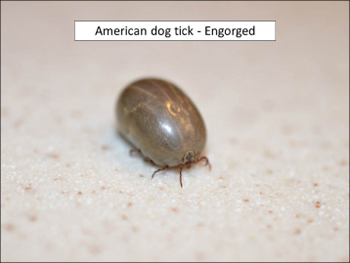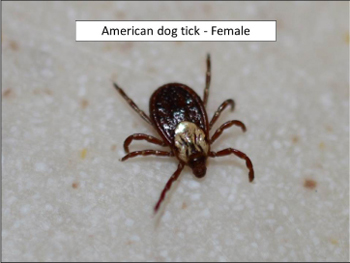Ticks in Johnson County, Kansas

Because ticks develop in four stages: egg, larva, nymph and adult, they can be difficult to detect.
We’re most familiar with the adult versions of the three common tick species found in Johnson County:
- the American dog tick,
- the Lone star tick and
- the Brown dog tick.
 The female Lone star tick is easiest to identify with her characteristic white dot (lone star) in the center of her back, but the younger immature versions take more effort to identify or even see. The larva stage, often referred to as a seed tick, can look more like small specks slowly moving around on your skin.
The female Lone star tick is easiest to identify with her characteristic white dot (lone star) in the center of her back, but the younger immature versions take more effort to identify or even see. The larva stage, often referred to as a seed tick, can look more like small specks slowly moving around on your skin.
And the hardest of all ticks to identify is the smallest, the black-legged tick, also called the deer tick.
Ticks typically feed on native wildlife or domestic livestock to meet their need for a blood host. Once they have fed, they drop to the ground and molt into the next stage. They repeat the process three times as they move from the larva to the nymph to the adult stage. Each time they feed they look for a mouse, small rodent, a bird, or a deer to complete the process. Unfortunately, if a dog or cat is close by, or even a human, a tick will try to latch on and feed. That’s when ticks cause us problems because of the possibility they are carrying diseases like Rocky Mountain Spotted Fever and Lyme disease.
The best defense against ticks is prevention. Stay out of taller grass and wooded areas that tend to be their best habitat. When you do go into those areas, wear light clothing so you can spot them easier and when you get back home, check for ticks.
Here are a few tick facts to keep in mind:
- Ticks do not jump or drop from trees. Ticks crawl onto blades of grass, weeds, or low bushes and wait for a host to brush against the vegetation. The tick immediately releases from the vegetation and crawls onto the host.
- While it’s best to avoid going into tall grass, weeds, and brushy areas, DEET-based repellents, (N,N diethyl-meta-toluamide) and permethrin, work well to keep ticks away.
- To control ticks on pets, use flea and tick collars, sprays, dips, or drops specifically labeled for your dog or cat.
- If you do find a tick attached to your skin, it can be removed by grasping as close to the skin as possible with fine tweezers. Pull slowly straight away from the skin, using slow, steady pressure. Ticks removed within 24-48 hours are much less likely to transmit any diseases.
If you need help identifying ticks, take them to your local Cooperative Extension Service office. Staff there should be able to identify them or send them into one of our state entomologists.
Check out this article on Ticks in Kansas.
You are welcome to bring a sample to our Johnson County K-State Extension Office Map to our office.
Tick Quick Facts
Ticks are carriers of several diseases that can impact humans and animals. When adventuring outside to walk your dog or hit the parks, there are several ways to help keep yourself safe.
- Wear light colors and long sleeves and pants – this makes seeing ticks on clothing much easier and makes it more difficult for ticks to make it to skin.
- Use insect repellant – repellants should contain DEET or permethrin (but keep in mind that permethrin products should not be applied directly to the skin)
- Manage vegetation around your home – tall grass and weedy areas are prime habitat locations for ticks.
- Remove ticks immediately – check yourself, your children, and your pets immediately when you get home. Remove any ticks that haven’t attached immediately, and use tweezers or forceps to remove attached ticks with a slow and steady movement, do not twist or jerk.
- Not every bite means disease – ticks removed within several hours of attaching are unlikely to transmit pathogens.